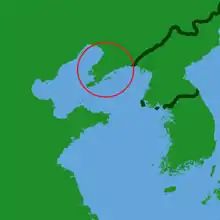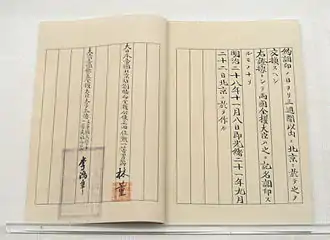Liaodong Peninsula
The Liaodong Peninsula (also Liaotung Peninsula, simplified Chinese: 辽东半岛; traditional Chinese: 遼東半島; pinyin: Liáodōng Bàndǎo) is a peninsula in southern Liaoning province in Northeast China, and makes up the southwestern coastal half of the Liaodong region. It is located between the mouths of the Daliao River (the historical lower section of the Liao River) in the west and the Yalu River in the east, and encompasses the territories of the whole sub-provincial city of Dalian and parts of prefectural cities of Yingkou, Anshan and Dandong.

The word "Liaodong" literally means "east of the Liao region", referring to the Warring States period Yan commandery of Liaodong, which encompassed an area from modern Liaoning-Jilin border in the north to the Chongchon River in the south, and from just east of the Qian Mountains to the Daling River in the west. The modern usage of "Liaodong" however simply refers to the half of Liaoning province that is east of the Liao River.
Geography

The Liaodong Peninsula lies on the northern shore of the Yellow Sea, dividing the Liaodong Bay (the largest of the three bays of the Bohai Sea) to its west from the Korea Bay to its east. It forms the southern part of a mountain belt that continues northward in the Changbai Mountains. The part of the mountain range on the peninsula is known as the Qianshan Mountains, named after Qian Mountain in Anshan, which includes Dahei Mountain in Dalian.
History
Pre-Han
The Liaodong region was settled since prehistoric times by Neolithic people such as Xinle culture. It later came under the rule of the Gojoseon kingdom, which encompassed the northern Korean Peninsula and the region southeast of the Liao River. In the late 4th century BC, the expanding Chinese State of Yan conquered this region from Gojoseon,[1] and established the Liaodong Commandery.
Han to Qing
After the fall of the Yan state, the region was taken over by the short-lived Qin Dynasty, and then its prominent successor Han Dynasty. After the Han Dynasty fragmented at the turn of the 3rd century, the region changed hands between various warlord states such as the Gongsun Yuan, the nomadic Wuhuan, and Cao Wei, before eventually falling under the reunified Western Jin dynasty.
However, after the Western Jin fell from the Uprising of the Five Barbarians and during the subsequent chaotic Sixteen Kingdoms periods, the region was ruled by Former Yan, Former Qin, Later Yan[2] and later Goguryeo, before being reconquered by the Tang Dynasty.
In 698 AD, Wu Zhou's defeat at the Battle of Tianmenling allowed the newly found Balhae to rule the region for the next two centuries, before taken over by the Khitan Liao Dynasty, and followed by the Jin dynasty, Yuan dynasty, Ming dynasty and Qing dynasty.
20th century

The peninsula was an important area of conflict during the First Sino-Japanese War (1894–1895). Defeat precipitated decline in the Qing dynasty which was exploited by colonial powers who extracted numerous concessions. The peninsula was ceded to Japan, along with Taiwan and Penghu, by the Treaty of Shimonoseki of 17 April 1895. However the ceding of Liaodong peninsula was rescinded after the Triple Intervention of 23 April 1895 by Russia, France and Germany. In the aftermath of this intervention, the Russian government pressured the Qing dynasty to lease Liaodong and the strategically important Lüshunkou (Port Arthur) for use by the Russian Navy.
As in the First Sino-Japanese War, the Liaodong peninsula was the scene of major fighting in the Russo-Japanese War (1904–1905), including the bloody Siege of Port Arthur. As a consequence of the Treaty of Portsmouth (5 September 1905), which ended the Russo-Japanese War, both sides agreed to evacuate Manchuria and return it to China, with the exception of the Liaodong Peninsula leased territory which was transferred to Japan,[3] which was to administer it as the Kwantung Leased Territory.
After Japan lost World War II, and the People's Republic of China was established in 1949, Liaodong was again under unified Chinese rule, where it has been to this day.
References
- Yi, Ki-baek (1984). A New History of Korea (Translated ed.). Cambridge: Harvard University Press. p. 16. ISBN 9780674615762.
- Grousset, Rene (1970). The Empire of the Steppes. Rutgers University Press. pp. 57. ISBN 0-8135-1304-9.
- Article Five:The Imperial Government of Russia transfer and assign to the Imperial Government of Japan, with the consent of the Government of China, the lease of Port Arthur, Ta-Lien and the adjacent territory and territorial waters, and all rights, privileges and concessions connected with or forming part of such lease (…)
| Look up Liaodong Peninsula in Wiktionary, the free dictionary. |